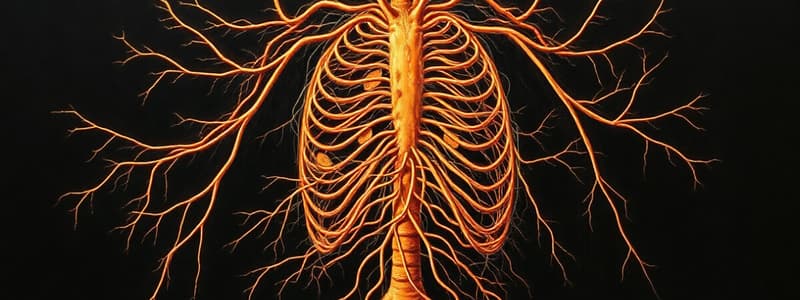Podcast
Questions and Answers
Which of the following correctly describes the function of the central nervous system?
Which of the following correctly describes the function of the central nervous system?
- Controls involuntary actions without need for brain input
- Processes sensory information and produces responses (correct)
- Regulates voluntary muscle movements
- Coordinates with the peripheral nervous system to control reflex actions
What is the role of the ciliary muscle in the human eye?
What is the role of the ciliary muscle in the human eye?
- To change the shape of the lens for focusing (correct)
- To supply nutrients and oxygen to the retina
- To regulate the pupil size based on light intensity
- To protect the eye from foreign particles
Which statement about rod and cone cells in the retina is accurate?
Which statement about rod and cone cells in the retina is accurate?
- Both rod and cone cells are primarily involved in peripheral vision
- Cone cells are sensitive to colors of light, while rod cells detect light intensity (correct)
- Rod cells are responsible for daytime vision, while cone cells are for night vision
- Rod cells detect color while cone cells detect light intensity
What distinguishes involuntary actions from voluntary actions?
What distinguishes involuntary actions from voluntary actions?
Which structure in the eye is primarily responsible for focusing light onto the retina?
Which structure in the eye is primarily responsible for focusing light onto the retina?
The blind spot in the human eye is characterized by which of the following?
The blind spot in the human eye is characterized by which of the following?
What is the purpose of the choroid layer in the eye?
What is the purpose of the choroid layer in the eye?
Which concept correctly describes how reflex actions are mediated?
Which concept correctly describes how reflex actions are mediated?
Flashcards
What is the central nervous system?
What is the central nervous system?
The central nervous system (CNS) consists of the brain and spinal cord which control and coordinate all body functions.
What is the peripheral nervous system?
What is the peripheral nervous system?
The peripheral nervous system (PNS) is made up of nerves that connect the CNS to the rest of the body.
What are voluntary actions?
What are voluntary actions?
Voluntary actions are those that are done consciously and under our control, like writing, eating, or walking.
What are involuntary actions?
What are involuntary actions?
Signup and view all the flashcards
What is the sclera?
What is the sclera?
Signup and view all the flashcards
What is the cornea?
What is the cornea?
Signup and view all the flashcards
What is the iris?
What is the iris?
Signup and view all the flashcards
What is the retina?
What is the retina?
Signup and view all the flashcards
Study Notes
Human Nervous System
- Consists of central nervous system (CNS) and peripheral nervous system (PNS)
- CNS includes brain and spinal cord
- PNS includes cranial nerves (12 pairs) and spinal nerves (31 pairs)
- The nervous system controls and coordinates organs and body parts
- Detects stimuli, sends information as impulses, interprets impulses to produce appropriate responses
Function of Human Nervous System
- Detects stimuli
- Sends information in the form of impulses
- Interprets impulses
- Produces appropriate responses
Voluntary Actions
- Conscious actions, conducted under one's will
- Controlled by the brain
- Examples include writing, reading, singing, eating, walking
Involuntary Actions
- Occur immediately without conscious control or prior thoughts
- Classified into two categories
- Involving medulla oblongata, including heartbeat, breathing, peristalsis and saliva secretion
- Involving spinal cord (reflex actions), including sneezing when dust enters the nose
Importance of Human Nervous System in Daily Life
- Controls and coordinates organs and body parts
- Carries out processes in the body and daily activities
Structure of the Eye
- Sclera: Strong outer layer that maintains the shape and protects the eye
- Cornea: Transparent layer that refracts and focuses light
- Ciliary Muscles: Muscles that change lens shape to focus light on the retina
- Eye Lens: Transparent and elastic, focusing light onto the retina
- Iris: Coloured part of the eye, controlling the size of the pupil, regulating light entering
- Pupil: Opening in the centre of the iris, controlling the amount of light
- Aqueous humour: Transparent fluid that maintains the shape of the eyeball and focuses light
- Vitreous humour: Transparent jelly-like substance maintaining eye shape and focusing light
- Retina: Layer containing photoreceptors that detect light and produce nerve impulses
- Rod Cells: Sensitive to different light intensities
- Cone Cells: Sensitive to different colours of light
- Optic Nerves: Transmit nerve impulses from the retina to the brain for interpretation
- Blind Spot: Region of the retina without photoreceptors, an exit point for optic nerve fibers.
Studying That Suits You
Use AI to generate personalized quizzes and flashcards to suit your learning preferences.



